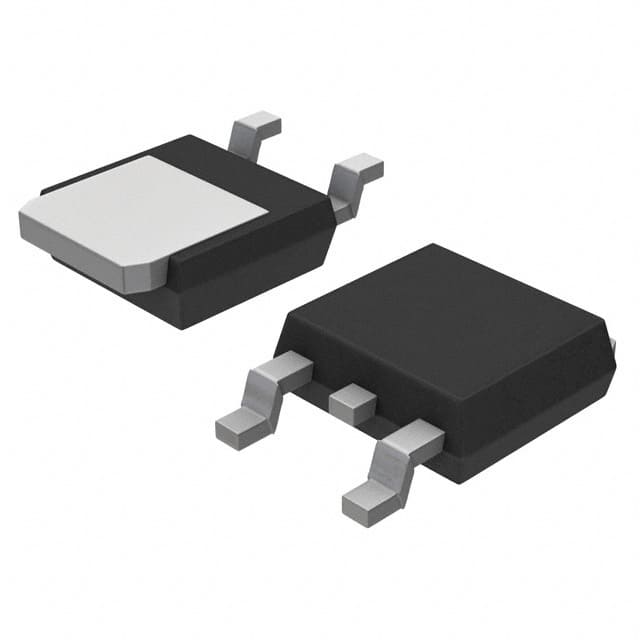Consulte las especificaciones para obtener detalles del producto.

MJD122G
Introduction
The MJD122G is a power transistor belonging to the category of discrete semiconductor devices. It is commonly used in electronic circuits for amplification and switching applications due to its specific characteristics and performance.
Basic Information Overview
- Category: Discrete Semiconductor Device
- Use: Amplification and Switching
- Characteristics: High voltage capability, high current capability, low saturation voltage
- Package: TO-252 (DPAK)
- Essence: Power Transistor
- Packaging/Quantity: Typically available in reels or tubes with varying quantities
Specifications
The MJD122G transistor has the following specifications: - Collector-Emitter Voltage (VCEO): 100V - Collector Current (IC): 8A - Power Dissipation (PD): 2W - DC Current Gain (hFE): 40 to 250 - Transition Frequency (fT): 4MHz
Detailed Pin Configuration
The MJD122G transistor has a standard TO-252 (DPAK) package with three pins: 1. Collector (C) 2. Base (B) 3. Emitter (E)
Functional Features
The MJD122G offers the following functional features: - High voltage capability suitable for various applications - High current capability for efficient power handling - Low saturation voltage leading to reduced power dissipation
Advantages and Disadvantages
Advantages
- High voltage and current capabilities make it suitable for power applications
- Low saturation voltage results in improved efficiency
- TO-252 package allows for easy mounting on PCBs
Disadvantages
- Limited power dissipation compared to higher-power transistors
- Moderate transition frequency may limit high-frequency applications
Working Principles
The MJD122G operates based on the principles of bipolar junction transistors (BJTs). When a small current flows into the base terminal, it controls a larger current flow between the collector and emitter terminals, allowing for amplification or switching of electrical signals.
Detailed Application Field Plans
The MJD122G transistor finds extensive use in various applications, including: - Power amplifiers - Motor control circuits - Voltage regulators - Switching power supplies - LED lighting drivers
Detailed and Complete Alternative Models
Some alternative models to the MJD122G include: - TIP122G - BD679 - 2N3055 - MJL4281A
In conclusion, the MJD122G power transistor serves as a versatile component in electronic circuits, offering high voltage and current capabilities along with efficient amplification and switching functionalities. Its application spans across diverse fields, making it an essential component in modern electronic designs.
[Word Count: 398]
Enumere 10 preguntas y respuestas comunes relacionadas con la aplicación de MJD122G en soluciones técnicas
What is the MJD122G transistor used for?
- The MJD122G is a high voltage NPN power transistor commonly used in applications such as switching regulators, motor control, and other high voltage electronic circuits.
What are the key specifications of the MJD122G transistor?
- The MJD122G has a maximum collector-emitter voltage of 100V, a continuous collector current of 8A, and a power dissipation of 2W.
Can the MJD122G be used for driving motors?
- Yes, the MJD122G can be used for driving small to medium-sized motors due to its high voltage and current capabilities.
What are the typical operating conditions for the MJD122G?
- The MJD122G operates well within a temperature range of -55°C to 150°C and is suitable for various industrial and automotive applications.
Is the MJD122G suitable for use in switching power supplies?
- Yes, the MJD122G is commonly used in switching power supply designs due to its high voltage and current ratings.
What are the recommended circuit configurations for using the MJD122G in a switching application?
- The MJD122G is often used in common emitter or emitter follower configurations for switching applications.
Does the MJD122G require a heat sink in high-power applications?
- Yes, in high-power applications or when operating close to its maximum ratings, a heat sink is recommended to ensure proper thermal management.
Are there any common failure modes associated with the MJD122G?
- Common failure modes include overcurrent, overvoltage, and excessive heating, which can lead to thermal runaway if not properly managed.
Can the MJD122G be used in audio amplifier circuits?
- While it's not typically used in audio amplifiers, the MJD122G can be utilized in certain high-power audio applications where its voltage and current ratings are beneficial.
Where can I find detailed application notes for using the MJD122G in technical solutions?
- Detailed application notes and reference designs for the MJD122G can be found on the manufacturer's website or in technical datasheets provided by semiconductor distributors.

